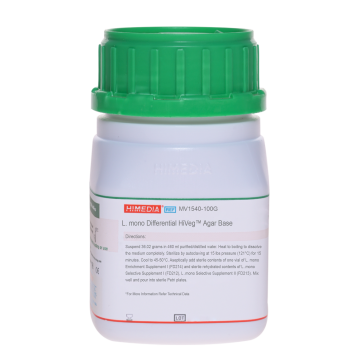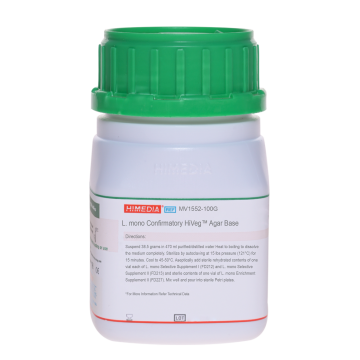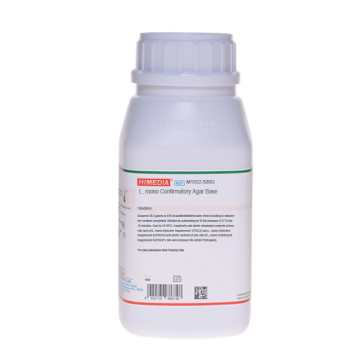 Your enquiry has been submitted
Your enquiry has been submitted
HiCrome™ Listeria Ottaviani Agosti Agar Base
Intended use
Recommended for the selective and differential isolation of Listeria monocytogenes. The composition and performance criteria of this media is as per the specification laid down in ISO 11290-1:2017 and ISO 11290-2:2017.
Composition**
M1540I - HiCrome™ Listeria Ottaviani-Agosti Agar Base
| Ingredients | g / L |
|---|---|
| HM Peptone # | 18.000 |
| Tryptone ## | 6.000 |
| Yeast extract | 10.000 |
| Sodium pyruvate | 2.000 |
| Glucose(Dextrose) | 2.000 |
| Magnesium glycerophosphate | 1.000 |
| Magnesium sulphate | 0.500 |
| Sodium chloride | 5.000 |
| Lithium chloride | 10.000 |
| Disodium hydrogen phosphate | 2.500 |
| 5-Bromo-4 chloro-3-indolyl-β-D-glucopyranoside | 0.050 |
| Agar | 15.000 |
Final pH ( at 25°C) 7.2±0.2
**Formula adjusted, standardized to suit performance parameters
Key : # - Equivalent to Enzymatic digest of animal tissues, ## - Equivalent to Enzymatic digest of casein
Supplements to be added after autoclaving
FD212A - 2 vials: OA Selective Supplement
| Ingredients | mg / vial |
|---|---|
| Nalidixic acid sodium salt | 10.000 |
| Ceftazidime | 10.000 |
| Polymyxin B sulfate | 38350 IU |
| Amphotericin B | 5.000 |
(FD214) - 2 vials: LP Enrichment Supplement 1
| Ingredients | Quantity |
|---|---|
| L-α- phosphatidylinositol | 1.000g |
Directions
Suspend 36.02 gram in 465 ml purified/distilled water. Heat to boiling to dissolve the medium completely. Sterilize by autoclaving at 15 lbs pressure (121°C) for 15 minutes. Cool to 45-50°C. Aseptically add sterile contents of 1 vial of LP Enrichment Supplement 1 (FD214) and sterile rehydrated contents of OA Selective Supplement (FD212A). Mix well and pour into sterile Petri plates.
Principle And Interpretation
Listeria monocytogenes is a gram-positive foodborne human pathogen responsible for serious infections in pregnant women that may ultimately result in abortion, stillbirth, birth of a child with neonatal listeriosis and meningitis or primary bacteremia in adults and juveniles. The pathogenicity of Listeria ivanovii for humans is uncertain. Since L.monocytogenes and L.innocua have similar biochemical properties, they cannot be differentiated on traditional media (PALCAM, Oxford). The media is based on the formulation of Ottoviani and Agosti (1,2) for the selective and differential isolation of L.monocytogenes from food and animal feeds which is adopted by ISO Committee (3,4,5). It is also recommended by APHA (6) & FDA-BAM (7).
HM peptone, tryptone and yeast extract supplies nitrogenous and carbonaceous compounds, long chain amino acids, vitamins and other essential nutrients. Sodium pyruvate provide essential growth nutrients. Glucose (Dextrose) is the fermentable carbohydrate. Sodium chloride maintains osmotic equilibrium. Phosphate buffers the medium. Lithium chloride and added selective supplements (FD212A) inhibit accompanying microflora and allow the growth of Listeria species. Listeria species hydrolyse the chromogenic substrate (5-Bromo-4 chloro-3-indolyl-β-D-glucopyranoside) which produces blue to green coloured colonies. Differentiation of L.monocytogenes from other Listeria species is based on phosphatidylinositol-specific phospholipase C (PIPLC) activity. Phospholipase C enzyme hydrolyses the purified substrate (FD214) added to the medium resulting in an opaque halo around L.monocytogenes colonies.
Type of specimen
Food and animal feeds, environmental samples in the area of food manufacturing and handling.
Specimen Collection and Handling
For food and animal feeds, environmental samples follow appropriate techniques for handling specimens as per established guidelines (3-7). After use, contaminated materials must be sterilized by autoclaving before discarding.
Warning and Precautions
Read the label before opening the container. Wear protective gloves/protective clothing/eye protection/ face protection. Follow good microbiological lab practices while handling specimens and culture. Standard precautions as per established guidelines should be followed while handling specimens. Safety guidelines may be referred in individual safety data sheets.
Limitations
- Some strains of L.monocytogenes exposed to stress condition particularly acid stress may show a very weak halo (or even no halo).
- Further biochemical tests must be carried out to differentiate between L.monocytogenes and L.ivanovii, sine both shows opaque halo of PIPLC activity.
- Some organisms other than Listeria spp. may also produce blue colonies on this medium, so biochemical characterization is required for differentiation.
- Further biochemical and serological test are need to be carried out for confirmation.
Performance and Evaluation
Performance of the medium is expected when used as per the direction on the label within the expiry period when stored at recommended temperature.
Quality Control
Appearance Cream to yellow homogeneous free flowing powder
Gelling Firm, comparable with 1.5% Agar gel
Colour and Clarity of prepared medium Light amber coloured, opalescent gel forms in Petri plates
Reaction Reaction of 7.2% w/v aqueous solution at 25°C.
pH 7.00-7.40
Cultural Response
Productivity : Cultural characteristics observed with added sterile OA Selective Supplement (FD212A) and LP Enrichment Supplement 1 (FD214) after an incubation at 37°±1°C for 48±4 hours. Recovery rate is considered as 100% for bacteria growth on Reference medium - Soyabean Casein Digest Agar (Tryptone Soya Agar). The characteristic reaction are compared with previously approved lot.
Specificity : Cultural characteristics observed with added sterile OA Selective Supplement (FD212A) and LP Enrichment Supplement 1 (FD214) after an incubation at 37°±1°C for 48±4 hours. The characteristic reaction are compared with previously approved lot.
Selectivity : Cultural characteristics observed with added sterile OA Selective Supplement (FD212A) and LP Enrichment Supplement 1 (FD214) after an incubation at 37° ± 1°C for 48 ± 4 hours .
| Organism | Inoculum (CFU) | Growth | Recovery | Colour of colony | PIPLC activity |
|---|---|---|---|---|---|
| Productivity | |||||
| Listeria monocytogenes ATCC 13932 (00021*) | 50-100 | luxuriant | >=50% | Blue-green | positive, opaque halo around the colony exhibiting phophatidylinositol specific phospholipase activity |
| Listeria monocytogenes ATCC 35152 (00109*) | 50-100 | luxuriant | >=50% | Blue-green | positive, opaque halo around the colony exhibiting phophatidylinositol specific phospholipase activity |
| Specificity | |||||
| Listeria innocua ATCC 33090 (00017*) | 103-104 | luxuriant | - | Blue-green | negative |
| Selectivity | |||||
| Escherichia coli ATCC 25922 (00013*) | >=104 | inhibited | - | - | - |
| Escherichia coli ATCC 8739 (00012*) | >=104 | inhibited | - | - | - |
| Enterococcus faecalis ATCC 19433 (00009*) | >=104 | inhibited | - | - | - |
| Enterococcus faecalis ATCC 29212 (00087*) | >=104 | inhibited | - | - | - |
Storage and Shelf Life
Store between 15-25°C in a tightly closed container and the prepared medium at 2-8°C. Use before expiry date on the label. On opening, product should be properly stored dry, after tightly capping the bottle in order to prevent lump formation due to the hygroscopic nature of the product. Improper storage of the product may lead to lump formation. Store in dry ventilated area protected from extremes of temperature and sources of ignition Seal the container tightly after use. Product performance is best if used within stated expiry period.
Disposal
User must ensure safe disposal by autoclaving and/or incineration of used or unusable preparations of this product. Follow established laboratory procedures in disposing of infectious materials and material that comes into contact with sample must be decontaminated and disposed of in accordance with current laboratory techniques (8,9).
Reference
- Ottaviani F., Ottaviani M., and Agosti M. (1997 a), Industrie Alimentari 36, 1-3.
- Ottaviani F., Ottaviani M., and Agosti M. (1997 b), Quimper Froid Symposium Proceedings p. 6, A.D.R.I.A. Quimper, France, 16-18 June 1997.
- Microbiology of the food chain — Horizontal method for the detection and enumeration of Listeria monocytogenes and of Listeria spp. - Part 1 , Detection method ; ISO 11290-1:2017.
- Microbiology of the food chain — Horizontal method for the detection and enumeration of Listeria monocytogenes and of Listeria spp. - Part 2 , Enumeration method ; ISO 11290-2:2017.
- Microbiology of food, animal feeding stuffs and water- Preparation, production,storage and performance testing of culture media, EN ISO 11133:2014 (E) /Amd.2020.
- Salfinger Y. and Tortorello M. L., (Eds.), 2015, Compendium of Methods for the Microbiological Examination of Foods, 5th Ed.,APHA, Washington, D.C.
- BAM Chapter 10: Detection of Listeria monocytogenes in Foods and Environmental Samples, and Enumeration of Listeria monocytogenes in Foods, 2022.
- Isenberg, H.D. Clinical Microbiology Procedures Handbook 2nd Edition.
- Jorgensen, J.H., Pfaller, M.A., Carroll, K.C., Funke, G., Landry, M.L., Richter, S.S and Warnock., D.W. (2015) Manual of Clinical Microbiology, 11th Edition. Vol. 1.
| Product Name | HiCrome™ Listeria Ottaviani Agosti Agar Base |
|---|---|
| SKU | M1540I |
| Product Type | Regular |
| Physical Form | Powder |
| Origin | Animal |
| Packaging type | HDPE |
| References | 1.Isenberg, H.D. Clinical Microbiology Procedures Handbook. 2nd Edition. 2.Jorgensen,J.H., Pfaller , M.A., Carroll, K.C., Funke, G., Landry, M.L., Richter, S.S and Warnock., D.W. (2015) Manual of Clinical Microbiology, 11th Edition. Vol. 1. |
| Customized Product Available | No |









